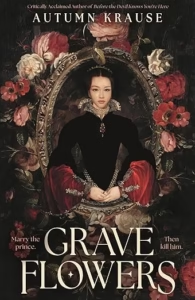Grave Flowers
Autumn Krause
Peachtree Teen
Published September 2, 2025
Amazon | Bookshop | Goodreads
About Grave Flowers
A twisty, dark royalcore fantasy that takes the courtly intrigue of Hamlet and infuses it with the vicious ambition of the Boleyn family. For readers who love Holly Black and Sarah J. Maas.
“A sumptuously dark tale of revenge and atonement that beautifully explores the ties both duty and family use to claim us. From the first page to the last, I was dazzled.” —Erin A. Craig, #1 New York Times bestselling author of The Thirteenth Child
Marry the prince, then kill him.
Princess Madalina and her twin sister, Inessa, were born attached at the hand and separated right after. That’s the only time the sisters ever held hands. The girls’ personalities have been shaped in the Sinet family’s drive to make their kingdom more than what it is: unrespectable and loathsome, a damp place where deceit fills the palace walls like mold.
Madalina is different from her family. She’s considered the weak one and only finds peace in the garden, tending her magical flowers, which are pejoratively called grave flowers because they are ideal for torture and torment. Secretly, she dreams of escape and a new life.
Then Inessa, who was betrothed to the heir of a wealthy kingdom—Prince Aeric—gets trapped in Bide, a terrifying purgatory, and begs Madalina to set her free. Now, not only must Madalina take her sister’s place as Aeric’s bride-to-be, but she also must finish Inessa’s secret mission: Inessa wasn’t just sent to marry Prince Aeric, but to kill him, too, and solidify a profitable pact with his traitorous uncle.
On behalf of her family, Madalina will need to resist the infuriatingly clever prince—as well as her own heart—if she’s to free her sister and finish the job.
My Review
Dangerous plants star in this twisting tale of love and political intrigue. At first, it seems the flowers are simply a quirk of the fantasy world, and Princess Madalina’s passion project. As the story progresses, we learn more about the king’s experiment with them. It takes time for the connection between those experiments and the challenges Madalina faces to become apparent.
I liked the tenuous connection between Madalina and Aeric. They bond over their neglectful childhoods and the loss of parents they were closest to. They both hide big secrets.
I do wish there had been more explanation of Aeric’s behavior, though. Sometimes he would say wildly romantic things about wanting to protect Madalina forever and kissing no one else but her, as his betrothed. But then he would be aloof and remote at other times. I get that in those moments he withdrew on purpose. I think I just wanted a little more connecting of those two disparate parts of his personality, especially at the end.
Madalina and Inessa were born conjoined twins, separated at birth. The fact that they were conjoined is hidden from everyone but their parents. They each bear a scar on their hands from their separation. The scar connects them in strange ways, so the plot depends on conjoined twin magic in some places.
On the whole, the story world is dark and imaginative. I think that will appeal to a lot of readers looking for dark fantasy right now. The romance is tender and stays pretty PG, which makes this accessible to a broad audience.
Readers who enjoyed House of Salt and Sorrows by Erin A. Craig or A Forgery of Roses by Jessica S. Olson will want to check this one out.
Content Notes
Recommended for Ages 14 up.
Profanity/Crude Language Content
One instance of mild profanity.
Romance/Sexual Content
Kissing. References to human trafficking.
Spiritual Content
Grave flowers have supernatural abilities. Drinking the nectar of one flower reveals someone’s secrets. Another flower’s roots can devour a human. Madaline sees spirits or ghosts of people who have died. The people generally worship the Primeval Family, a group of powerful deities, who sit in judgment over humanity in the afterlife. One can sidestep facing judgment by being sent to Bide, a purgatory-like place.
Violent Content
Situations of peril. Several descriptions of murder. After her death, Inessa visits Madaline, but her body undergoes strange changes, such as decay and a hunger for unusual things, including an insect. Between the chapters of the story, records of experiments with the grave flowers show violent deaths, some at the hands of the plants themselves. References to child abuse and execution. Brief body horror.
Drug Content
Characters drink wine at social events. The prince tricks Madalina into drinking more wine than she intended, so she lowers her guard in conversation with him. The prince is apparently drunk in several scenes.
Note: This post contains affiliate links, which do not cost you anything to use but help support this blog. I received a free copy of this book in exchange for my honest review. All opinions are my own.
